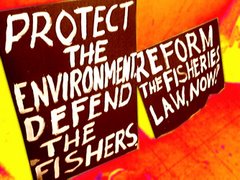
August 14, 2010
Press Statement
COAL IS THE MOST EXPENSIVE.
Vince Cinches
Coordinator, Visayas Climate Action Network
Executive Director
FIDEC Inc.
The governor may have been ill-informed when she said that renewable energy may be costly for ordinary household-level electricity consumers. This may be true years ago when a law-governing investment and development in the RE sector is nowhere to be found.
On the contrary, a 10-year sustainable energy roadmap of WWF-Philippines showed that if we shift to tapping renewable resources will result in lower power costs in the long term and will save the country a whooping $2.3B dollars annually, a savings that would mean a lot in providing social services, such as health and education, and not for posters of politicians plastered in government projects.
It is expected that the cost of oil and coal will go up in the coming years by as much as 64% while costs for RE technology will go down as it matures.
High costs in terms of taxes, tariffs, VAT, import duties among other things in operating renewable sources of energy is a thing of the past.
The Implementing Rules and Regulations (IRR) of the Philippine Renewable Energy Act or Republic Act No. 9513 signed into law last December, is aimed at accelerating the development and use of the nation’s vast renewable energy resources through fiscal and non-fiscal incentives for investors, among which are:
• Seven-year income tax holidays for RE developers
• Exemption from VAT and duty-free importation of equipment and machinery
• Reduction of corporate income tax after the expiry of the income tax holiday, to 10 percent of net income
• Zero percent VAT rate for the sale of power from RE
• Duty-free importation of equipment
• Tax credit on domestic capital equipment and services
• Special realty tax rates, income tax holidays, net operating loss carry-over, accelerated depreciation and exemption from the universal charge and wheeling charges.
• Exemption from all taxes of the proceeds from the sale of carbon credits.
• Assurance to investors in wind, solar, ocean, run-of-river hydropower and biomass in electricity generated from these clean sources through feed-in tariffs.
The current bias of the provincial government towards coal is a violation of such law, it provides that we need to allocate a certain portion from clean, home-grown renewable energy sources, Cebu have vast renewable energy potential specifically in HYDRO POWER for Argao and Ginatilan, WIND POWER for Carmen and Oslob(wind park), BIOMASS for Bogo, and Solar everywhere. The DOE has revealed that the country’s renewable energy potential is vast – with 4,531 MW from geothermal; 13,097 MW from hydropower, 277 MBFOE from biomass; 5.0-5.1 kWh/m2/day from solar; 76,600 MW from wind; and 170,000 MW from oceanic waves.
The provincial government should look into the sustainable opportunity that we are offering and should not be antagonistic in their stance just because we don’t agree with their development paradigm. They should open their eyes and look at the valid merits of our objectives.
It is our duty as taxpayers and stakeholders to correct governmental policies that we deemed unsustainable and wrong. This is governance, and they should now do their part.
The current market price of electricity in the province is already expensive as it is: in fact we rank next to Japan. The government’s power development plan will cost consumers more. Nationwide it is going to cost us an extra $4.7B, because of over capacity due to flaws in demand projections. Their basic overly optimistic assumption is that GDP will grow by 5.7 % each year, however National Statistical Coordination Board says that annual average growth is on the average of 3.6 percent. This is what happened when agencies refused to include other stakeholders in developing energy needs.
We know that having no electricity is going to be bad for the economy, the same thing as having too much will result to high rates due to Purchased Power Adjustments. In the end this will punish the common household-level electricity consumers, by paying for the excess energy. We have an installed capacity of almost 16,000 MW and a peak demand of 9,069 mw, so technically we are paying for both actual consumption and for unutilized energy.
On the other hand the market price of coal is only half the story, if we are going to include “external costs”. In terms of carbon emission budget / climate change, mining, combustion, waste disposal, environment, human health, food security, contamination of water supplies, heavy metals, coal now becomes the most expensive energy source, one that we pay with our lives and with the very fabric of our existence.
The baliligate was due to greed and poor value judgement, we have seen how it causes misery, how it divested the people with 100 million of taxpayers’ money. We don’t want it to happen again.
We have an option, and one that is without coal in it.##
Sources Philippine Electricity Demand Projections, by Maitet Diokno-pascual
True Cost of Coal – Greenpeace International





